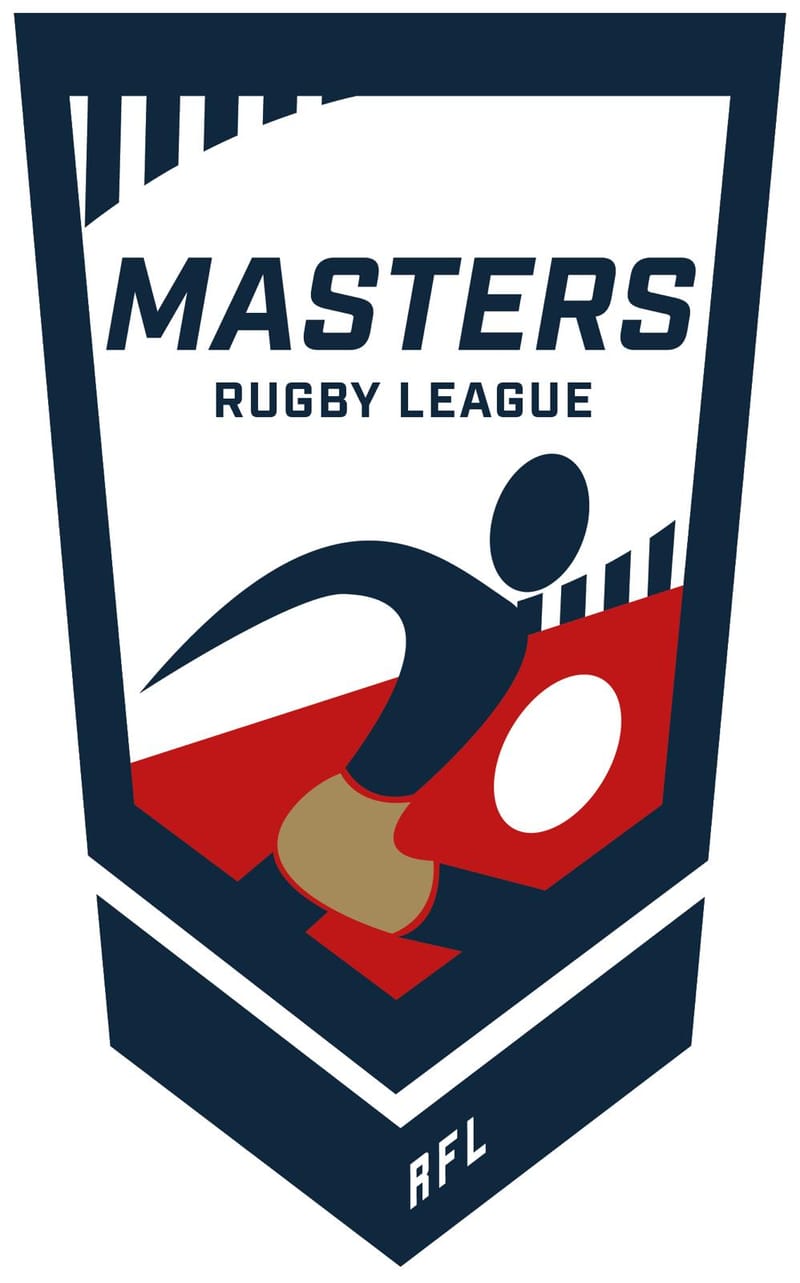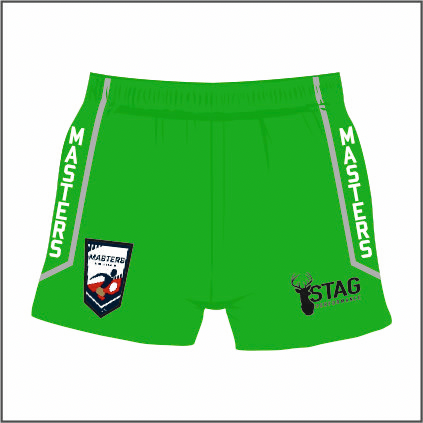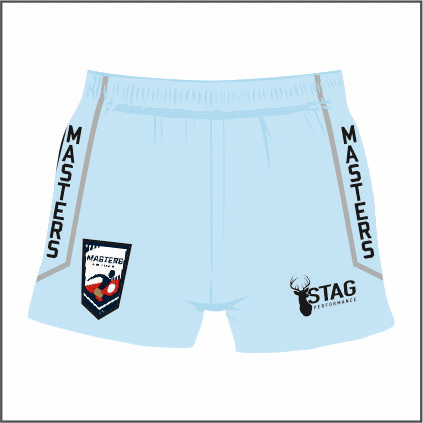
Introduction
Masters Rugby League is strictly a social version of the sport for the over 35s.
The rules are slightly modified to cater for the older gentleman where the safety of old bones is paramount.
Spirit of Masters
- Masters is non-competitive.
- Masters does not welcome nor allow rough or over vigorous play.
- Master is about enjoyment and having a good time – on and off the pitch!
- There are no winners; no champions; no leagues; no cup finals.
- All games end in a 0-0 draw.
Masters referees shall referee the games strictly to Masters rules and in the Spirit of Masters.
The International Rules of Rugby League apply in full with the following exceptions for MASTERS.
- Age groups
- Tackling
- Running with ball
- Play the ball
- Advantage
- Scrums
- Penalties
- Sixth tackle
- Kicking
- Restarts
- Kicks at goal
- Number of players
- Duration of Games
- Misconduct
1. Age groups[1]
White and Black


White and black short players tend to tackle each other normally.
Red

On attack, red short players must be physically stopped and held: not necessarily brought to ground.
On defence, red short players must have a minimum of a definite 2 handed positive hold on the attacker.
GOLD – GREEN – BLUE



In defence, a gold short player touches his opponent: he stands at the point of the tackle and raises his hand to indicate the tackle to the referee. The tackled player MUST return to the point of the tackle to play the ball. [2]
On attack, the defender must remove the tag from the gold short player. No other contact with the gold short player is permitted. The tackling player stands at the point of the tackle and raises his hand and the tag to indicate the tackle to the referee. The tackled gold short player MUST return to the point of the tackle to play the ball. [3]
Green and sky blue short players follow the requirements for gold.
2. Tackling
In all cases, players are to succumb to tackles rather than try to keep progressing.
Only two players are allowed in a tackle. [4]
No lifting – no throws.
All tackles are to be below the shoulders.
No drag down tackles from behind.
No stripping of the ball – including 1 on 1 tackles.
Ankle taps are not allowed.
3. Running with ball
Players may run as hard as they wish as long as they run at GAPS.
Players are not allowed to try and run over the top of each other.
Players are not allowed to fend or hand off.
Players are not allowed to “barge over” to score.
4. Play the ball
TWO markers are permitted.
All other defenders must retire 5 metres minimum at the play the ball.
Markers and defenders are passive and must not move until the acting halfback has the ball in his hands.
Dummy half is allowed to run from play the ball BUT cannot score and if tackled in possession a sixth-tackle is awarded with scrum head and feed to defending side.
5. Advantage
Advantage from a knock on or a forward pass shall be allowed when possession of the ball is cleanly and safely transferred to the non-infringing team. In all other cases advantage is expressly not allowed.
6. Scrums
No pushing/pulling in scrums is allowed to avoid injuries (it is accepted that teams will win their own ball back i.e. scrums go with feed). All six forwards must participate in scrums.
The scrum half must not follow opposing scrum half around the base of the scrum.
The attacking team scrum half can pick the ball up and run from the base of the scrum.
Loose forward cannot break off the base of the scrum with the ball: scrum half must receive the ball from the scrum
When the ball or player is in touch a scrum is formed 20 m in from touch.
Lateral positioning of scrums does not apply.
7. Penalties
All penalties are a tap kick on the mark, given by the referee, at point of the misconduct.
All defenders must retreat FIVE metres.
The “six again rule does not apply”.
8. Sixth tackle
There are no turnovers.
Sixth tackle results in a scrum to the defending side.
9. Kicking
Kicking in general play is only allowed on the last tackle. [5]
For all kicks, including kick-offs and goal line dropouts, the receiving team must receive the ball. Receiver must not be challenged and must be allowed to run at least 5 metres. [6]
ONLY in the unlikely event that the receiving team makes no attempt to claim the ball and kicking team players are onside, the referee may call play on [7] and the kicking team may re-gather the ball.
10. Restarts
From kick offs and goal line dropouts, if the ball bounces out untouched by receiving team, the scrum goes to the receiving team.
ALL restarts are controlled by the referee!
11. Kicks at goal
There are no kicks at goal.
12. Number of players
The game is played with teams of a maximum of 13 players per team [8]. Each team can name up to 7 replacement players [9]. Unlimited interchanges are allowed. Interchanges may occur at any time.
13. Duration of games
A game is normally of 50 minutes duration. There will be a half time interval of 5 minutes. [10]
14. Misconduct
Sin bin [11]
FIVE minutes – player stands in player’s in-goal area behind the posts
Sending off [11]
Player is excluded for rest of the match and/or festival.
[1] ALL players must wear correct short colour for their age. Exceptions can be agreed where a player through medical need requires the protection of gold shorts. Exceptions to be agreed with referee prior to game. When an active player (35-59yrs) wears gold shorts as protection due to injury or for any other reason, they are not to wear tags and are tackled by touch only. In the Spirit of Masters, under age gold players may not move away from acting half back to tackle.
[2] Referee shall if required blow his whistle to stop play and ensure play restarts at the point of the tackle.
[3] Gold short player is counted as a tackler
[5] 20:40 and 40:20 rule does not apply.
[6] This applies even in the case where a player does not gather the ball cleanly.
[7] Referee will only call “play on” when he is certain there is no risk of player collision.
[8] In the spirit of Masters, where a team is unable to field 13 players at the start of a game or at any time during the game, the opposition is required to reduce their number of players on the field to the corresponding number or to loan players to ensure balanced teams. At the start of a game, the size of the playing area may also be reduced in agreement between team captains and the referee.
[9] It is permissible for teams to use more than 7 replacements but not where this would give an unfair advantage.
[10] The duration of games may be modified at festivals to suit the number of teams participating or the time available and on any occasion in agreement between team captains and the referee. No more than 60 minutes of scheduled Masters game time per team.
[11] Players sin-binned or dismissed may be replaced.